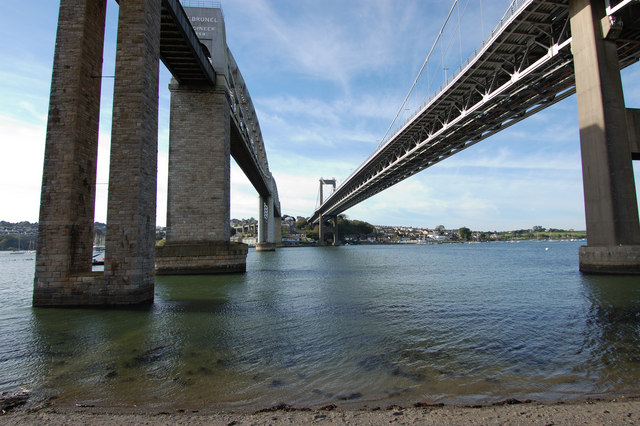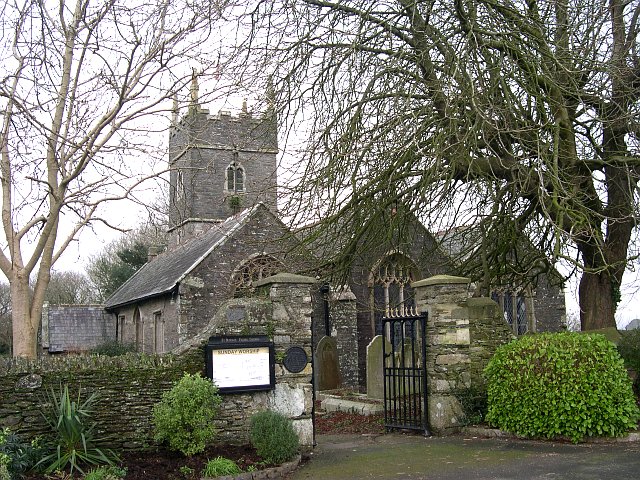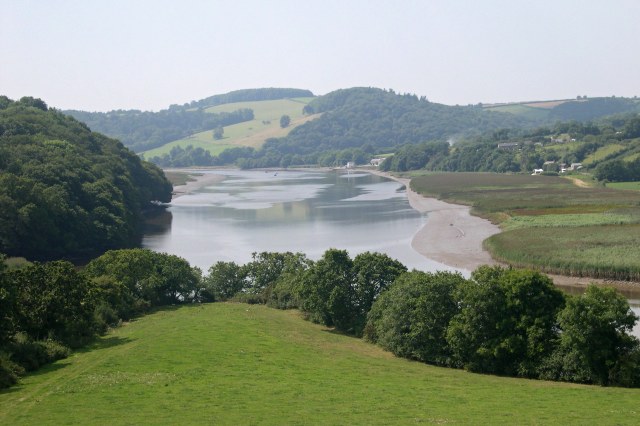|
Saltash Ferry
The Saltash Ferry was a ferry across the River Tamar between Saltash, Cornwall and Plymouth, Devon. It was replaced in 1961 by the Tamar Bridge. History There had been a ferry service across this section of the Tamar since the time of the Norman Conquest. At the time, there was no public crossing of the Tamar downstream of Gunnislake, to the north. Initial ferries were powered by oar and ropes. The service was owned by the Valletort family in the 12th and early 13th centuries before being sold in 1270. In 1385, the Burgesses of Saltash were granted a lease to run the ferry for 200 years. In 1733, it capsized and sank, with the loss of 20 lives. The ferry was revived in 1832 by John Parker, 1st Earl of Morley and Sir William Molesworth, who established Royal Assent for a floating bridge steam ferry across the Tamar. It was constructed by James Meadows Rendel the following year, and could accommodate up to four horse carriages. The service was unreliable and withdrawn a year la ... [...More Info...] [...Related Items...] OR: [Wikipedia] [Google] [Baidu] |
Saltash Slipway
Saltash (Cornish: Essa) is a town and civil parish in south Cornwall, England, United Kingdom. It had a population of 16,184 in 2011 census. Saltash faces the city of Plymouth over the River Tamar and is popularly known as "the Gateway to Cornwall". Saltash’s landmarks include the Tamar Bridge which connects Plymouth to Cornwall by road, and the Royal Albert Bridge. The area of Latchbrook is part of the town. Description Saltash is the location of Isambard Kingdom Brunel's Royal Albert Bridge, opened by Prince Albert on 2 May 1859. It takes the railway line across the River Tamar. Alongside it is the Tamar Bridge, a toll bridge carrying the A38 trunk road, which in 2001 became the first suspension bridge to be widened whilst remaining open to traffic. Saltash railway station, which has a regular train service, with some routes between London Paddington station is close to the town centre. Stagecoach South West, Plymouth Citybus, and Go Cornwall Bus operate bus services ... [...More Info...] [...Related Items...] OR: [Wikipedia] [Google] [Baidu] |
Royal Assent
Royal assent is the method by which a monarch formally approves an act of the legislature, either directly or through an official acting on the monarch's behalf. In some jurisdictions, royal assent is equivalent to promulgation, while in others that is a separate step. Under a modern constitutional monarchy, royal assent is considered little more than a formality. Even in nations such as the United Kingdom, Norway, the Netherlands, Liechtenstein and Monaco which still, in theory, permit their monarch to withhold assent to laws, the monarch almost never does so, except in a dire political emergency or on advice of government. While the power to veto by withholding royal assent was once exercised often by European monarchs, such an occurrence has been very rare since the eighteenth century. Royal assent is typically associated with elaborate ceremony. In the United Kingdom the Sovereign may appear personally in the House of Lords or may appoint Lords Commissioners, who announce ... [...More Info...] [...Related Items...] OR: [Wikipedia] [Google] [Baidu] |
Ferry Transport In England
A ferry is a ship, watercraft or amphibious vehicle used to carry passengers, and sometimes vehicles and cargo, across a body of water. A passenger ferry with many stops, such as in Venice, Italy, is sometimes called a water bus or water taxi. Ferries form a part of the public transport systems of many waterside cities and islands, allowing direct transit between points at a capital cost much lower than bridges or tunnels. Ship connections of much larger distances (such as over long distances in water bodies like the Mediterranean Sea) may also be called ferry services, and many carry vehicles. History In ancient times The profession of the ferryman is embodied in Greek mythology in Charon, the boatman who transported souls across the River Styx to the Underworld. Speculation that a pair of oxen propelled a ship having a water wheel can be found in 4th century Roman literature "''Anonymus De Rebus Bellicis''". Though impractical, there is no reason why it could not work ... [...More Info...] [...Related Items...] OR: [Wikipedia] [Google] [Baidu] |
Torpoint Ferry
The Torpoint Ferry is a car and pedestrian chain ferry connecting the A374 which crosses the Hamoaze, a stretch of water at the mouth of the River Tamar, between Devonport in Plymouth and Torpoint in Cornwall. The service was established in 1791 and chain ferry operations were introduced by James Meadows Rendel in 1832. Current operations The route is currently served by three ferries, built by Ferguson Shipbuilders Ltd at Port Glasgow and named after three rivers in the area: '' Tamar II'', '' Lynher II'' and ''Plym II''. Each ferry carries 73 cars and operates using its own set of slipways and parallel chains, with a vehicle weight limit of The ferry boats are propelled across the river by pulling themselves on the chains; the chains then sink to the bottom to allow shipping movements in the river. An intensive service is provided, with service frequencies ranging from every 10 minutes (3 ferries in service) at peak times, to half-hourly (1 ferry in service) at night. Serv ... [...More Info...] [...Related Items...] OR: [Wikipedia] [Google] [Baidu] |
The Blitz
The Blitz was a German bombing campaign against the United Kingdom in 1940 and 1941, during the Second World War. The term was first used by the British press and originated from the term , the German word meaning 'lightning war'. The Germans conducted mass air attacks against industrial targets, towns, and cities, beginning with raids on London towards the end of the Battle of Britain in 1940 (a battle for daylight air superiority between the Luftwaffe and the Royal Air Force over the United Kingdom). By September 1940, the Luftwaffe had lost the Battle of Britain and the German air fleets () were ordered to attack London, to draw RAF Fighter Command into a battle of annihilation.Price 1990, p. 12. Adolf Hitler and Reichsmarschall Hermann Göring, commander-in-chief of the Luftwaffe, ordered the new policy on 6 September 1940. From 7 September 1940, London was systematically bombed by the Luftwaffe for 56 of the following 57 days and nights. Most notable was a large dayligh ... [...More Info...] [...Related Items...] OR: [Wikipedia] [Google] [Baidu] |
St Budeaux
St Budeaux is an area and ward in the north west of Plymouth in the English county of Devon. Original settlement The name St Budeaux comes from Saint Budoc, the Bishop of Dol (Brittany). Around 480, Budoc is said to have founded a settlement and built a small church. The church eventually gave way to a permanent stone one, dedicated to Saint Budoc, which was erected shortly before the Norman conquest of England. The village is documented in William the Conqueror's Domesday Book of 1086. Known as Bucheside, it was valued at 30 shillings (around six times the amount of neighbouring manors). Over the course of the next few hundred years, Bucheside became Bodekishide, Budeokshed, and even Bottockishide and Butshead, the latter form being recorded on the Trevill monuments in the church. The modern name, St Budeaux, is itself a Frenchified "elegant" form. 15th to 18th centuries St Budeaux became a separate parish in 1482 by the decision of the Bishop of Exeter. During the early T ... [...More Info...] [...Related Items...] OR: [Wikipedia] [Google] [Baidu] |
World War II
World War II or the Second World War, often abbreviated as WWII or WW2, was a world war that lasted from 1939 to 1945. It involved the vast majority of the world's countries—including all of the great powers—forming two opposing military alliances: the Allies and the Axis powers. World War II was a total war that directly involved more than 100 million personnel from more than 30 countries. The major participants in the war threw their entire economic, industrial, and scientific capabilities behind the war effort, blurring the distinction between civilian and military resources. Aircraft played a major role in the conflict, enabling the strategic bombing of population centres and deploying the only two nuclear weapons ever used in war. World War II was by far the deadliest conflict in human history; it resulted in 70 to 85 million fatalities, mostly among civilians. Tens of millions died due to genocides (including the Holocaust), starvation, ma ... [...More Info...] [...Related Items...] OR: [Wikipedia] [Google] [Baidu] |
Normandy Landings
The Normandy landings were the landing operations and associated airborne operations on Tuesday, 6 June 1944 of the Allied invasion of Normandy in Operation Overlord during World War II. Codenamed Operation Neptune and often referred to as D-Day, it was the largest seaborne invasion in history. The operation began the liberation of France (and later western Europe) and laid the foundations of the Allied victory on the Western Front. Planning for the operation began in 1943. In the months leading up to the invasion, the Allies conducted a substantial military deception, codenamed Operation Bodyguard, to mislead the Germans as to the date and location of the main Allied landings. The weather on D-Day was far from ideal, and the operation had to be delayed 24 hours; a further postponement would have meant a delay of at least two weeks, as the invasion planners had requirements for the phase of the moon, the tides, and the time of day that meant only a few days each month were ... [...More Info...] [...Related Items...] OR: [Wikipedia] [Google] [Baidu] |
James Meadows Rendel (engineer)
James Meadows Rendel FRS (December 1799 – 21 November 1856) was a British civil engineer. Early life and career Rendel was the son of the surveyor James Rendel or Rendle and his wife Jane, daughter of the architect John Meadows (died 1791); he was born near Okehampton, Devon, in 1799. He was initiated into the operations of a millwright under an uncle at Teignmouth, while from his father he learnt some civil engineering. At an early age he went to London as a surveyor under Thomas Telford, by whom he was employed on the surveys for the proposed suspension bridge across the Mersey at Runcorn. About 1822 he settled at Plymouth, and commenced the construction of roads in the north of Devon. One of his smaller projects, still surviving, was an 1826 bridge over Bowcombe Creek on the Kingsbridge Estuary. In August 1824 he was employed by the Earl of Morley in making a bridge across the Catwater, an estuary of the Plym within the harbour of Plymouth at Laira. To guard against the u ... [...More Info...] [...Related Items...] OR: [Wikipedia] [Google] [Baidu] |
Cable Ferry
A cable ferry (including the terms chain ferry, swing ferry, floating bridge, or punt) is a ferry that is guided (and in many cases propelled) across a river or large body of water by cables connected to both shores. Early cable ferries often used either rope or steel chains, with the latter resulting in the alternative name of chain ferry. Both of these were largely replaced by wire cable by the late 19th century. Types There are three types of cable ferry: the reaction ferry, which uses the power of the river to tack across the current; the powered cable ferry, which uses engines or electric motors (e.g., the Canby Ferry in the U.S. State of Oregon) to wind itself across; and the hand-operated type, such as the Stratford-upon-Avon chain ferry in the UK and the Saugatuck Chain Ferry in Saugatuck, Michigan, United States. Powered cable ferries use powered wheels or drums on board the vessel to pull itself along by the cables. The chains or wire ropes can be used with a su ... [...More Info...] [...Related Items...] OR: [Wikipedia] [Google] [Baidu] |
Sir William Molesworth, 8th Baronet
Sir William Molesworth, 8th Baronet, (23 May 181022 October 1855) was a Radical British politician, who served in the coalition cabinet of The Earl of Aberdeen from 1853 until his death in 1855 as First Commissioner of Works and then Secretary of State for the Colonies. Much later, when justifying to the Queen his own new appointments, Gladstone told her: "For instance, even in Ld Aberdeen's Govt, in 52, Sir William Molesworth had been selected, at that time, a very advanced Radical, but who was perfectly harmless, & took little, or no part... He said these people generally became very moderate, when they were in office", which she admitted had been the case. Background Molesworth was born in London and succeeded to the baronetcy in 1823. He was educated privately before entering St John's College, Cambridge as a fellow commoner. Moving to Trinity College, he fought a duel with his tutor, and was sent down from the university. He also studied abroad and at Edinburgh Univers ... [...More Info...] [...Related Items...] OR: [Wikipedia] [Google] [Baidu] |
River Tamar
The Tamar (; kw, Dowr Tamar) is a river in south west England, that forms most of the border between Devon (to the east) and Cornwall (to the west). A part of the Tamar Valley is a World Heritage Site due to its historic mining activities. The Tamar's source is less than from the north Cornish coast, but it flows southward and its course runs across the peninsula to the south coast. The total length of the river is . At its mouth, the Tamar flows into the Hamoaze before entering Plymouth Sound, a bay of the English Channel. Tributaries of the river include the rivers Inny, Ottery, Kensey and Lynher (or ''St Germans River'') on the Cornish side, and the Deer and Tavy on the Devon side. The name Tamar (or Tamare) was mentioned by Ptolemy in the second century in his ''Geography''. The name is said to mean "great water."Furneaux, Robert. The Tamar: A Great Little River. Ex Libris Press. 1992. Foot, Sarah. ''The River Tamar''. Bossiney Books. 1989.Neale, John. Discovering ... [...More Info...] [...Related Items...] OR: [Wikipedia] [Google] [Baidu] |








